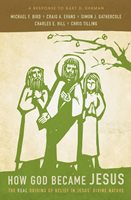It is not often that a book appears on the very same day as the book to which it is responding, but such is the case with Michael Bird’s (ed.) new How God Became Jesus: The Real Origins of Belief in Jesus’ Divine Nature – A Response to Bart D. Ehrman, making its appearance along with Bart Ehrman’s How Jesus Became God, both on March 25 of this year. The titles express succinctly the respective arguments advanced in each book – Bird (along with Craig Evans, Simon Gathercole, Charles Hill, and Chris Tilling) arguing for the historic, orthodox understanding of the person of Christ, and Ehrman continuing his well-known attempt to discredit it.
There are few topics more fundamental to Christian faith, and we were eager to talk with Michael Bird about his new book.
Books At a Glance (Fred Zaspel):
First, explain for us just briefly something of what gave rise to this book. What is the position Bart Ehrman is advocating – and that you are seeking to refute?
Bird:
Ehrman is arguing that recognition of Jesus’ divinity was a complex affair and it took some 300 years for Jesus to be recognized as “fully” divine as God Almighty. In the course of that argument he contends that there was a spectrum of degrees of divinity in the Greco-Roman and Jewish worlds with demi-gods, angels who become human, and humans who become gods. Jesus himself did not claim to be divine, but was merely a messianic prophet, who believed that the world would end. It didn’t end, however, and the only thing that ended was Jesus’ life. Jesus’ body was probably disposed of in some gruesome manner, but the disciples believed that Jesus rose from the dead, and on that basis they thereafter thought of him as “divine” in “some sense.” However, the “sense” in which they believed Jesus was “divine” was not uniform or consistent, but it developed along the lines of two models: exaltation (a human figure made divine) and incarnation (a pre-existent being who becomes human). So Mark, for instance, teaches an exaltation christology, while John teaches an incarnation christology. That’s Ehrman’s basic argument.
Books At a Glance:
Is there anything particularly new about these claims or this line of argument?
Bird:
Nothing Ehrman says is really new. Other scholars have been arguing the same kind of things for a while. But Ehrman is a good showman and he marries the scholarly narrative to his own personal biography of going from a fundamentalist to an agnostic.
 Books At a Glance:
Books At a Glance:
We will ask you for the positive evidence for the orthodox understanding of the person of Christ in a moment, but first, how does Ehrman’s case fare on the historical level? What does the information we have from the early church suggest in this regard? What about Ehrman’s claim that the orthodox high Christology arose only after a series of political battles?
Bird:
Ehrman is sometimes right, sometimes a little wrong, and sometimes a lot wrong. He is correct about several things like views of divine/semi-divine intermediary figures in antiquity but wrong about their relevance to NT christology. He is correct that Jesus was a messianic figure and a prophet but wrong about Jesus not seeing himself as party of the identity and activity of God. Ehrman is also right that christology did develop in the early church, but wrong about the trajectories that it took and wrong about the interpretation of key passages like Phil 2:5-11. A good example of where he is very, very wrong is his interpretation of Gal 4:14 where he suggests that Paul thought Jesus was an angel who became human! The number of scholars who would interpret the text this way could probably fit into the back seat of a Volvo. To his credit, Ehrman does not think that Jesus was made divine in the fourth century, he thinks Jesus was regarded as divine immediately after his supposed resurrection, but it is divinity in a lesser or relative sense compared to God the Father. So it is a mixed bag. You can genuinely learn some good things from Ehrman in his book, but not all that glistens is gold!
Books At a Glance:
Describe for us what you call the “big bang” of high Christology that occurs very early in the church’s history. Just when and how did this high Christology originate? And what did it look like?
Bird:
The thing that keeps historians of the early church awake at night is that Jesus was crucified by the Romans in about 30 AD. However, by 50-55 AD, the Apostle Paul is citing a well known hymn/proem in Phil 2:5-11 about the pre-existent Jesus becoming human and being exalted to the heights of heavenly glory with the monotheistic language of Isa 40:23. Similarly in 1 Cor 8:6, Paul takes the monotheistic language of Deut 6:4, the shema, the basic confession of YHWH as the one and only God, and applies it to Jesus. In other words, within 20 years of Jesus’ death, Christians are describing him with the honours, authority, activity, and identity normally ascribed to the God of Israel. That is bigger than Ben Hur and has more bang than a fourth of July party using fireworks packed with nuclear warheads. Its huge!
Books At a Glance:
What of this “high Christology” do we see in the words of Jesus himself?
Bird:
Well, we could always jump to the Gospel of John and look at things like the “I am” statements. However, since John is later and has a slightly thicker interpretive edge that he applies to the Jesus tradition which some scholars dismiss, its probably best to start with the Synoptic Gospels (Matthew, Mark, and Luke). One clear instance, one of my favourites, is the story of Jesus healing a paralysed man on the Sabbath (see Mark 2:1-10). The teachers of the law aren’t impressed that Jesus would do this on the Sabbath and they get rather irate when Jesus pronounces the forgiveness of sins over the man. Now it would be perfectly fine for a person to say this sort of thing … if he were a priest and if were in the temple. But Jesus is neither. He’s not a rogue priest who had purchased a Galilean franchise on the priesthood, licensing him to do healings, bar mitzvahs, and Jewish weddings. Nobody says, “Who can forgive sins except a priest?” The objection that “God alone” can forgive sins seems to mark out Jesus’ action as a clear violation of the expectations of monotheistic devotion. And yet Jesus does it, the healing takes place, and it looks as if the God of Israel not only approves of what he does, but even approves of who he says he is. We could give many examples, but that’s my favourite one for Jesus’ own christology.
Books At a Glance:
Do Matthew and Luke reflect an understanding of the preexistence of Jesus?
Bird:
They certainly do and my co-author Simon Gathercole does a cracking good job of showing this. In fact, he points out that the “I have come” sayings in the Synoptics point exactly to this kind of thing. For instance, “I have come to bring fire on the earth, and how I wish it were already kindled!” (Luk 12:49) depicts Jesus as the one coming, presumably from heaven, to usher in the eschatological judgment of God.
Books At a Glance:
Augustus and other of the Caesars claimed divinity. How are these different from the claims of Jesus’ deity found in the New Testament? And in that Jewish context how did these claims square with monotheism?
Bird:
The deification of Roman emperors – usually, but not always (e.g., Caligula and Nero), after their death – is really a complex thing and especially in its connection to the Roman imperial cults in their various expressions. But, generally put, emperors were thought to be divine in virtue of their achievements and special relationship to the ancient gods, with myths of their alleged descent from ancient gods like Jupiter or Apollo added in for good measure.
The big difference is, of course, that Jews did not think that humans can become divine in any real sense. If it is a creature then it is not God! Now god-language can be used rhetorically, just see Psalm 45 for instance, but in terms of ontology, the language of being/becoming, it was widely recognized that humans cannot climb a ladder to divinity. Such views were rejected by the most Jews, not just because of the self-aggrandizing claims that often lay at the root of them, but because they were simply inconsistent with the monotheism that the Jewish people knew, what they recited every day in the shema, a monotheism inherited by the early church.
So, however the early church regarded Jesus as divine, it wasn’t by cutting and pasting options taken over from the imperial cults.
Books At a Glance:
Just on the level of curiosity, your book was released at virtually the same moment as Ehrman’s book to which you were responding. That is really great timing, but how were you able to make that happen?
Bird:
Well, we basically went from idea to publication in 100 days! I saw the advertisement for Ehrman’s book at the Society of Biblical Literature in mid-November 2013. My heart instantly sank as I knew in the coming months that I’d be getting emails from folks around the world with questions and doubts that they wanted answered. So I decided to embark on a bold and timely exercise in preventive pastoral care by trying to come up with quick yet thorough critique of Ehrman on the issue of Jesus’ divinity. I gathered together a crack posse of biblical scholars who were experts in their field to join in and pitched the idea to Zondervan who thought the idea was courageous but that it might just come off. In the coming weeks, the contributors involved in the book (Craig Evans, Chris Tilling, Simon Gathercole, and Chuck Hill) did a fantastic job of getting the work done quickly, on time, and on target. The Zondervan team then put pedal to the metal to get the book out simultaneously with Ehrman’s. Thankfully HarperCollins and Ehrman were warmly cooperative and gave us a pre-copy version of the manuscript which we read and critiqued. So that’s how we did it. Lots of hard yakka over the 2013 Christmas break.

